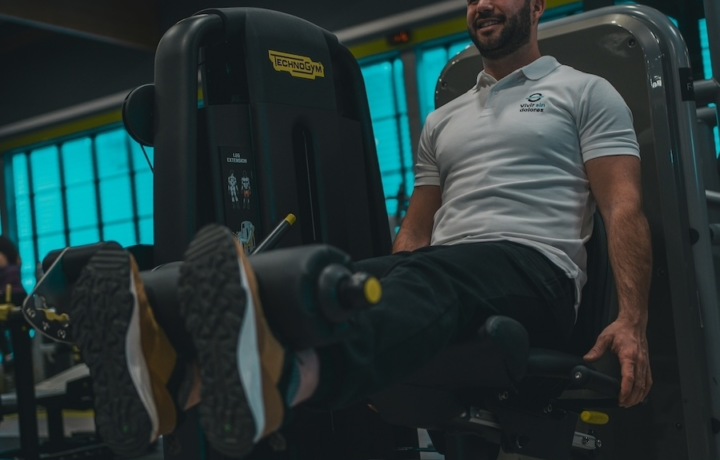Exercise
Barbell Front Squat

Barbell Front Squat
How to Perform
- Stand with feet shoulder-width apart, position the barbell on your front deltoids with elbows high and pointing forward, creating a shelf with your shoulders.
- Establish a grip slightly wider than shoulder-width, with fingers under the bar and wrists extended, keeping your upper arms parallel to the floor.
- Brace your core and take a deep breath in, maintaining a tall chest position and neutral spine throughout the movement.
- Begin the descent by breaking at the hips and knees simultaneously, keeping your weight distributed evenly through your entire foot.
- Lower your body until your thighs are at least parallel to the ground, while keeping your elbows up and torso as vertical as possible.
- At the bottom position, ensure your knees track in line with your toes and your heels remain firmly planted on the ground.
- Drive through your midfoot and heels to push yourself back up, exhaling as you pass the sticking point while maintaining your upright torso position.
- Fully extend your hips and knees at the top position without hyperextending your back, then reset your breath and core before beginning the next repetition.
Important information
- Keep your elbows high throughout the entire movement to prevent the bar from rolling forward off your shoulders.
- If wrist mobility is limiting your front rack position, try using a cross-arm grip or specialized lifting straps.
- Maintain an upright torso position more vertical than in a back squat to properly load the quadriceps and prevent the bar from falling forward.
- Start with lighter weights than you would use for back squats until you've mastered the front rack position and movement pattern.

Barbell Front Squat
Exercise Details
Primary Muscles
Muscle Groups
Mechanic
Risk Areas
Built for progress
Take the guesswork out of training
Create personalized AI-powered workout plans that evolve with you. Train smarter, track every rep and keep moving forward, one workout at a time.






The barbell front squat stands as a cornerstone compound movement in strength training that delivers exceptional results for intermediate lifters seeking to develop their lower body and core strength. Unlike its more common counterpart, the back squat, the front squat positions the barbell across the front of the shoulders, creating a more upright torso position that dramatically increases the activation of the quadriceps while still engaging the glutes significantly.
This exercise has earned its respected place in both powerlifting and bodybuilding circles for good reason. Powerlifters appreciate the front squat's ability to strengthen the quad dominance needed for competition squats and its carryover to improved positioning in deadlifts. Bodybuilders value its targeted quad development and the aesthetic benefits it brings to the anterior chain.
The front rack position engages the core musculature more intensely than many other squat variations, as your abdominals must work overtime to maintain an upright torso position throughout the movement. This core stabilization aspect makes the front squat particularly valuable for athletes looking to develop functional strength that transfers to sport-specific movements.
What sets the front squat apart is its joint-friendly nature compared to other squat variations. The more vertical torso position reduces shear forces on the lumbar spine, making it an excellent option for those with back concerns who still want to train heavy. The movement also demands and builds impressive mobility in the wrists, elbows, shoulders, and ankles – creating better overall movement patterns.
For intermediate lifters looking to break through plateaus, the front squat serves as both a humbling reality check and an effective strength builder. The exercise forces proper form – you simply cannot cheat a front squat without dropping the bar. This built-in feedback mechanism makes it an honest assessment of your true strength capabilities while simultaneously building the foundation for even greater gains in your overall training program.
FAQ - Barbell Front Squat
The barbell front squat primarily targets the quadriceps, while also engaging the glutes, adductors, and core muscles intensely. The front rack position creates greater quad activation compared to back squats, while maintaining significant glute recruitment and demanding superior core stability to maintain an upright torso.
Rest the barbell across your front deltoids with fingers under the bar in a clean grip position, elbows pointed forward and up at shoulder height. If wrist mobility is limited, you can use the cross-arm position where arms cross in front of you with the bar resting on your deltoids and hands holding the bar in place.
Yes, front squats typically place less shear force on the lumbar spine due to the more vertical torso position required. This makes them an excellent option for lifters with back concerns who still want to train heavy, though proper form remains crucial regardless of squat variation.
For intermediate lifters, incorporating front squats 1-2 times weekly allows for adequate recovery while promoting strength gains. You can program them as your primary squat movement on quad-focused days or as an accessory exercise after back squats, adjusting volume based on your recovery capacity.
The most common mistakes include dropping the elbows (causing the bar to roll forward), excessive forward lean, and allowing knees to collapse inward. Focus on maintaining high elbows throughout the movement, keeping your torso as upright as possible, and driving your knees outward in line with your toes during both descent and ascent.









